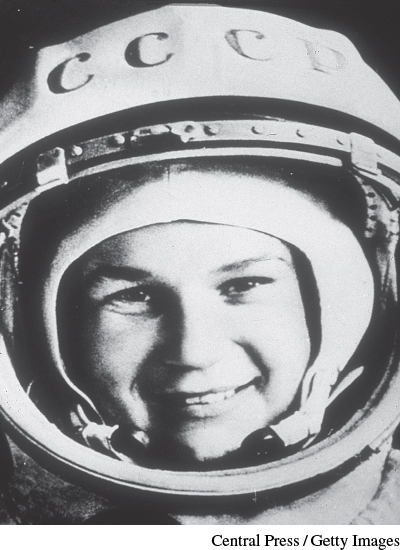The Space Age
The Space Age
The “space race” between the United States and the Soviet Union, also made possible by computers, began when the Soviets launched the satellite Sputnik in 1957. The competition led to increasingly complex space flights that tested humans’ ability to survive the process of space exploration, including weightlessness. Astronauts walked in space, endured weeks (and later months) in orbit, docked with other craft, fixed satellites, and carried out experiments for the military and private industry. In addition, a series of unmanned rockets launched weather, television, intelligence, and other communications satellites into orbit around the earth. In July 1969, a worldwide television audience watched as U.S. astronauts Neil Armstrong and Edwin “Buzz” Aldrin walked on the moon’s surface—the climactic moment in the space race.

The space race also influenced Western culture. Astronauts and cosmonauts were perhaps the era’s most admired heroes: Yuri Gagarin, John Glenn, and Valentina Tereshkova—the first woman in space—topped the list. A whole new fantasy world developed. Children’s toys and games revolved increasingly around space. Films such as 2001: A Space Odyssey (1968) portrayed space explorers answering questions about life that were formerly the domain of church leaders. Polish author Stanislaw Lem’s popular novel Solaris (1961), later made into a film, described space-age individuals engaged in personal quests that drew readers and ultimately viewers into a futuristic fantasy.
The space age grew out of cold war concerns, and advances in rocket technology not only launched vehicles into space but also powered destructive missiles. At the same time, the space age promoted and even depended on global cooperation. From the 1960s on, U.S. spaceflights often involved the participation of other countries. In 1965, an international consortium headed by the United States launched the first commercial communications satellite, Intelsat I—a feat envisioned since early in the postwar period. By the 1970s, some 150 countries were working together at more than four hundred stations worldwide to maintain global satellite communications. Although some 50 percent of satellites were for spying purposes, the rest promoted international communication and transnational collaboration.
Pure science flourished amid the space race. Astronomers used mineral samples from the moon to calculate the age of the solar system with unprecedented precision. Unmanned spacecraft provided data on cosmic radiation, magnetic fields, and infrared sources. Although the media depicted the space age as one of warrior astronauts conquering space, breakthroughs depended on the products of technology, including the radio telescope, which depicted space by receiving, measuring, and calculating nonvisible rays. These findings reinforced the so-called big bang theory of the origin of the universe, first outlined in the 1930s by American astronomer Edwin Hubble and given crucial support in the 1950s by the discovery of low-level radiation permeating the universe in all directions. The big bang theory proposes that the universe originated from the explosion of superdense, superhot matter some ten to twenty billion years ago.